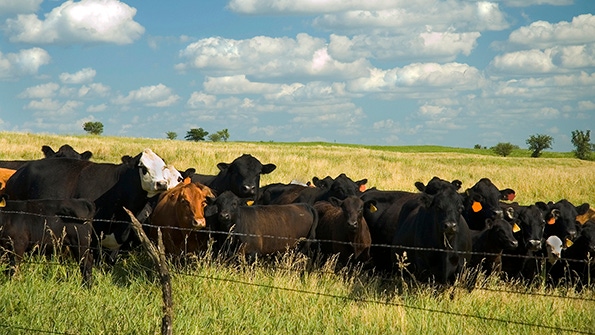Welcome to Health Ranch, where you can find information and resources to help you put the health and well-being of your cattle at the top of the priority list.
Smart strategies for a parasite control program
The right questions can lead to the right parasite control product choice for your cowherd. Here are 12 things to consider before you decide on your dewormer.
September 1, 2016

Sponsored Content
Antiparasitic resistance—the genetic ability of parasites to survive the effects of an antiparasitic drug that was previously effective—continues to grow in U.S. cattle.1
“We have little knowledge about the true extent of the problem,” said Dr. Ray Kaplan, DVM, PhD, University of Georgia College of Veterinary Medicine. “However, based on my own experience testing operations and discussing with colleagues around the country, resistance in some species of parasites is a real problem and quite widespread.”
Several factors contribute to antiparasitic resistance.1
Parasite biology and genetics
Immune status of the host animal
Drug mode of action and efficacy
Dose and frequency of treatments
“To help preserve the options we have, it’s important to use parasite control products according to label, and to avoid under- or over-dosing them,” said Dr. Doug Ensley, DVM, Professional Services Veterinarian with Boehringer Ingelheim Vetmedica, Inc. (BIVI), maker of Cydectin®.
The following good pasture management practices can also help fight resistance.
Rotate pastures with other livestock species.
Keep grass tall enough to help animals avoid exposure to parasite larvae, as more are typically found closer to the ground.
Reduce stocking density.
Managing “refugia” is a relatively new approach to tackling the issue, Kaplan said, and many producers may not understand it or be aware of its benefits. Refugia is the concept of leaving some internal parasites unexposed to a dewormer, essentially giving them refuge, and thereby reducing the drug-resistance selection pressure caused by the dewormer. It can help slow down the development of resistance.
Successful implementation of refugia may include:
Not deworming all cattle when there are few parasite larvae on the pasture. In the South, this would be during the hottest part of the year, and in the North, during the coldest part of the year.
Only deworming incoming cattle and leaving resident cattle untreated during extensive dry periods, when infection is low.
Not using the same class of dewormer on resident cattle repeatedly.
Not using a dewormer and then moving immediately to a clean pasture, as this will contaminate the new pasture with only resistant parasites.
Not deworming at least 10 percent of the animals, known as “selective non-treatment.”
“For the selective non-treatment strategy to work, it’s critical that for the 90 percent you are deworming, the drug you use is highly effective,” Kaplan cautioned.
Although managing refugia has not been tested with cattle parasites, Kaplan said numerous studies in sheep are convincing. “Maintaining refugia in a parasite management system can diminish the rate at which resistance develops, without sacrificing significant productivity.” 2
Consider refugia and work with your veterinarian to determine your herd’s parasite load and develop a parasite control program for your operation. Also think about the advantages of available tests—a coproculture (technique of allowing parasite eggs to hatch and identify species of parasite involved) to identify which species you’re fighting, and a fecal egg count reduction to help determine how successful your program really is.
Dewormer dilemma
The benefits of deworming your cattle are well known: increased weight gains and breeding efficiency, reduced pasture contamination, improved immune status and more.1 But it’s not as easy to know which deworming product to use.
“To reap these benefits and reduce the risk of resistance, it’s critical to use the most effective product at the most strategic times,” said BIVI’s Ensley. He recommends reviewing the following questions with your veterinarian. The answers will help you find the right parasite control product for your operation.
What type of operation do you have?
What parasite problems have you had in the past?
What have your deworming practices been in the past? Have you been satisfied?
Have you tested the effectiveness of your dewormer using a fecal egg count reduction test?
What climate do you live in? What are your parasite risks in the summer vs. winter?
What has the season been like this year?
What are your pasture management strategies?
How do you manage your cattle?
Do you process your cattle once per year or twice per year?
Are you handling your calves prior to weaning?
How do you market your calves? Do you hold them or sell them at weaning?
What are your grazing practices?
1 Antiparasitic resistance in cattle and small ruminants in the United States: How to detect it and what to do about it. FDA public meeting on antiparasitic drug use and resistance in ruminants and equines. Federal Drug Administration’s Center for Veterinary Medicine.
2 Busin V, Kenyon F, Laing N, Denwood MJ, McBean D, Sargison ND, Ellis K. Addressing sustainable sheep farming: Application of a targeted selective treatment approach for anthelmintic use on a commercial farm. Small Ruminant Research 2013;110:100-103.
SAFETY INFORMATION
CYDECTIN INJECTABLE: Do not treat cattle within 21 days of slaughter. Do not use in female dairy cattle of breeding age, veal calves or calves less than 8 weeks of age.
CYDECTIN POUR-ON: When used according to label, there is no slaughter withdrawal or milk discard time required. Do not use in veal calves.
You might also like:
Do small cows make more money?
13 utility tractors that will boost efficiency
About the Author(s)
You May Also Like
